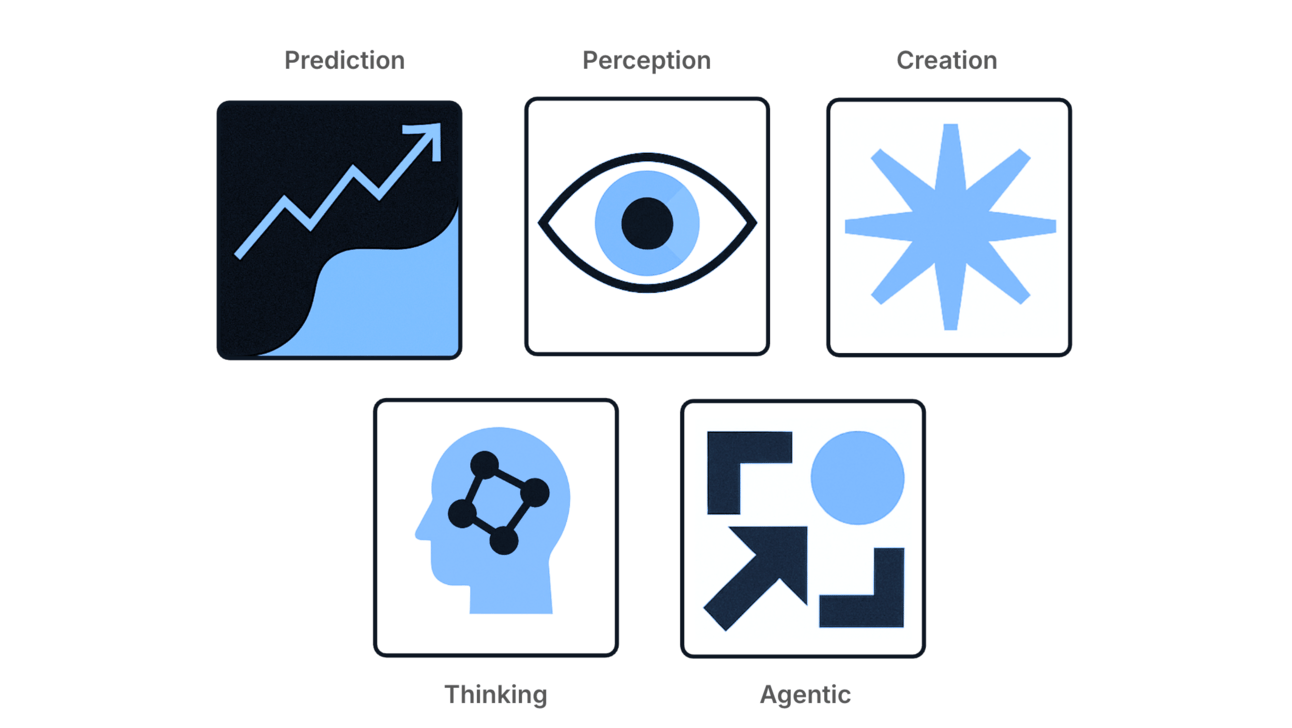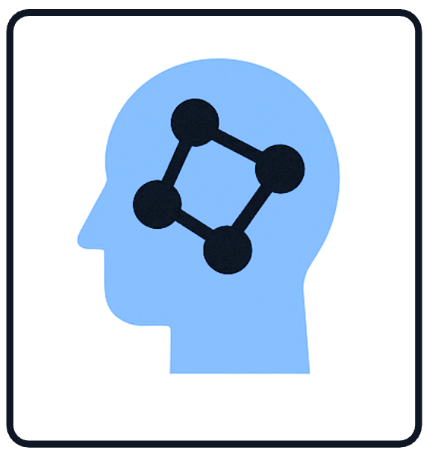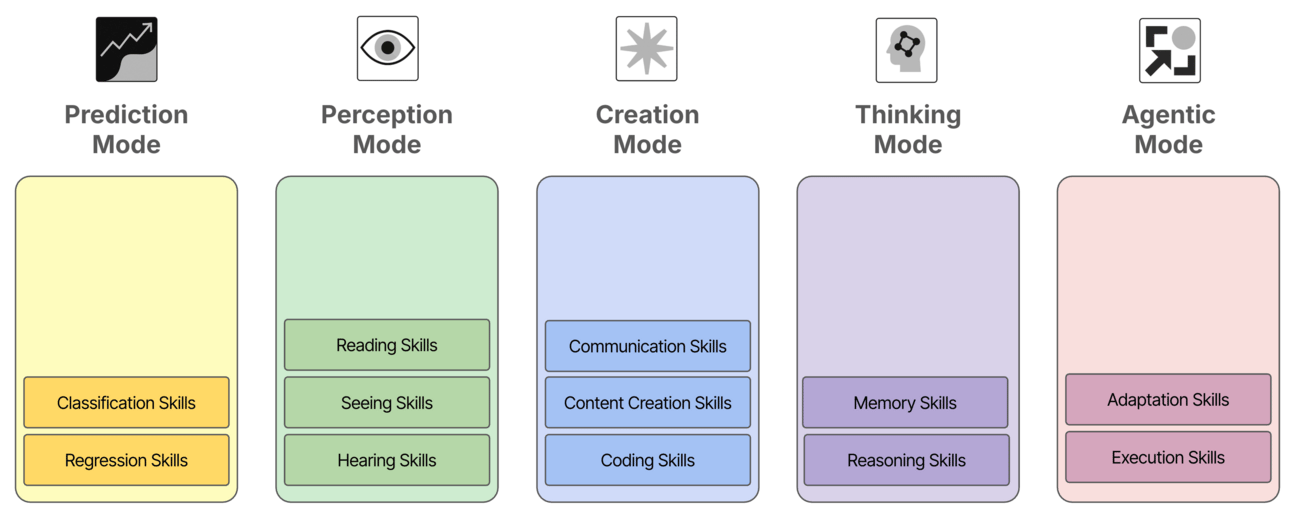- Profitable AI Weekly
- Posts
- 5 AI Modes for Business
5 AI Modes for Business
A practical framework for understanding what AI can actually do for you
How do you make AI understandable for the average person?
The problem is that most explanations land in one of two unhelpful places: either so technical that you need a PhD to understand them, or so abstract that you walk away without any clue what to actually do next.
But to actually apply AI to your business, you need a middle ground – not too technical, but grounded enough in reality to be actionable.
So I switched to something I tested with a few clients, and the response has been fantastic. As one told me: "Finally, that clicked for me!"
I want to make it click for you too.
Let me introduce you to the 5 AI Modes for Business.
The 5 AI Modes Framework
Instead of trying to memorize every AI tool or technology, here's a better question: What can this technology actually DO for me?
The 5 AI Modes break down modern AI into practical business capabilities. Capabilities that typically often require humans. Each mode represents a different way AI adds value – think of them as the core "skills" that AI brings to your team.
Here they are:

Prediction Mode: AI that anticipates what's next
Perception Mode: AI that sees, hears, and reads the world
Creation Mode: AI that builds and generates content
Thinking Mode: AI that reasons and connects the dots
Agentic Mode: AI that takes action and executes tasks
Each mode connects to specific technologies and tools – giving you a clear orientation for what to actually implement.
Let me walk you through each mode:

Prediction Mode
What it does: AI that anticipates future outcomes based on historical data – forecasting, scoring, and classifying information to help you make better decisions.
This is one of the oldest and most proven AI capabilities. You've seen it in action: Netflix recommending shows, banks detecting fraud, or Amazon knowing exactly when to restock inventory – that's Prediction Mode working behind the scenes.
Core skills: Classification (predict categories) and Regression (predict numbers)
Signal words: Forecast, estimate, score, classify, group, match, detect anomalies
Real examples:
Which leads are most likely to buy
When machines need maintenance before breaking
How much inventory to order next month
Which customers might cancel their subscription
Whether an email is spam or important
Which job applicants to interview first
Tools that do this:
Azure AutoML, SageMaker (Amazon), Google AutoML on the big platforms
H2O.ai for open source and enterprise AutoML
Salesforce Einstein for sales forecasting
Dataiku or DataRobot for end-to-end enterprise
Even Excel's forecasting features for simple predictions
ChatGPT, Claude, Gemini (for text-based classifications)
The catch: Prediction mode often needs clean, structured data to work well. Unlike other AI modes, there are hardly any "as-a-service" models here unless it’s a general-purpose problem (like spam detection). Otherwise, everything is typically custom-built or fine-tuned on your data. This makes Prediction Mode one of the highest entry barriers, which is why you need a clear business case before.

Perception Mode
What it does: AI that interprets the unstructured world – reading documents, analyzing images, and processing audio to turn messy inputs into usable business information.
Think of this as giving AI a bit of human-like senses. While Prediction Mode works with clean data, Perception Mode handles the messy stuff: scanned receipts, handwritten notes, photos of damaged products, or voice recordings from customer calls.
Core skills: Reading (text data), Seeing (images/videos), Hearing (speech, or audio analysis)
Signal words: Read, scan, look, recognize, listen, transcribe, extract, watch
Real examples:
Automatically extract invoice data from PDFs
Analyze photos to detect product defects
Transcribe customer service calls for quality review
Read handwritten forms and convert to digital data
Identify objects or people in security footage
Tools that do this:
ChatGPT-4o, Claude, Gemini for document analysis and image interpretation
Azure AI Vision, Google Cloud Vision for enterprise image processing
Otter.ai, Rev.ai for meeting transcription
Instabase, ABBYY for advanced document processing
Whisper (OpenAI) for speech-to-text
Perception Mode excels at turning analog inputs into digital workflows – making previously manual processes scalable.

Creation Mode
What it does: AI that produces original content – generating text, images, videos, or sound – or builds code, designs from simple prompts or complex instructions.
This is probably the AI mode most people have experienced. If you've asked ChatGPT to write an email, used Copilot to draft a presentation, or seen AI generate a video – you've used Creation Mode. It's about speed, scale, and lowering the barrier between having an idea and getting a working output.
Core skills: Content generation (text, images, video), Code generation, Communication (writing, translating, explaining)
Signal words: Write, generate, create, design, draft, compose, build, translate
Real examples:
Draft marketing emails and social media posts
Generate product descriptions from specifications
Create presentation slides from bullet points
Write code from natural language descriptions
Fixing bugs in a software project
Design logos and marketing visuals
Translate content across languages
Build first drafts of reports or proposals
Tools that do this:
ChatGPT, Claude, Gemini for text and code generation
Midjourney, DALL-E, Flux for image creation
Cursor, GitHub Copilot for coding assistance
Canva AI, Adobe Firefly for design work
Jasper, Copy.ai for marketing content
Synthesia, Runway, Veo for video generation
Creation Mode leverages and amplifies human creativity. Rarely coming up with truly original ideas, but excelling at mixing and matching patterns that worked.

Thinking Mode
What it does: AI that makes sense of things – reasons through complex problems, summarizes information, and connects insights across multiple sources – especially when the answer isn't obvious or requires interpretation.
This is where AI moves from "give me an answer" to "help me understand." When you need to synthesize a 40-page report, map customer feedback to product features, or figure out why a process keeps breaking, you need reasoning, not just text generation.
Core skills: Reasoning (analyze, interpret, summarize) and Memory (access stored knowledge, maintain context)
Signal words: Analyze, summarize, interpret, connect, decide, explain, understand, prioritize, recommend
Real examples:
Summarize quarterly board meeting notes into key action items
Analyze customer feedback to identify top product improvement themes
Review legal contracts and highlight potential risk clauses
Compare competitor features against your product roadmap
Interpret survey responses and suggest strategic recommendations
Route complex support tickets to the right specialist team
Connect sales objections to specific product messaging gaps
Tools that do this:
ChatGPT o3, Claude, Gemini for reasoning-heavy tasks
Perplexity for research and analysis
RAG platforms like Pinecone, Weaviate for knowledge-based reasoning
Notion AI, Obsidian for note analysis and synthesis
Custom chatbots built on your company documents
Unlike other modes, Thinking Mode often works best when connected to your specific knowledge base. Through techniques like RAG (Retrieval-Augmented Generation), these systems can pull relevant information from your documents, databases, or past conversations before reasoning through a response. This makes them incredibly powerful for domain-specific analysis – but also means they often require more setup than plug-and-play tools.

Agentic Mode
What it does: AI that takes action – based on a goal, it plans and executes tasks autonomously, and coordinates workflows across multiple systems without constant human supervision.
Most AI today is reactive. You ask, it responds. But Agentic Mode flips this: AI that proactively sends emails, updates spreadsheets, triggers workflows, and even learns from the results to improve over time. Think of it as AI that doesn't just give you the answer – it goes ahead and implements it.
Core skills: Execution (send, trigger, update, coordinate) and Adaptation (learn from feedback, optimize over time)
Signal words: Execute, send, update, trigger, coordinate, schedule, monitor, adapt, optimize, automate
Real examples:
Automatically follow up with leads who haven't responded in 3 days
Monitor project deadlines and send alerts to relevant team members
Update CRM records after every sales call without manual input
Reschedule meetings when conflicts arise across multiple calendars
Process refund requests and update accounting systems simultaneously
Generate and send weekly performance reports to department heads
Escalate support tickets when response times exceed thresholds
Tools that do this:
Zapier, n8n for workflow automation with AI agents
LangChain, CrewAI for building custom AI agents
HubSpot AI, Salesforce Einstein for CRM automation
Microsoft Power Automate for Office 365 integration
Custom AI assistants built on OpenAI Functions or Claude Tools
Reality check: Agentic Mode sounds like the ultimate solution, but it's by far the most complex AI mode. These systems need careful setup, monitoring, and guardrails to work reliably. While the idea of fully autonomous AI sounds amazing, the reality often requires significant technical expertise and ongoing maintenance. Start with simpler, lower AI automation solutions first, then graduate to agents once you understand your workflows deeply.
Bringing It Together
Here's the real power: these modes work best when combined.
When someone says "our customer support is too expensive," this framework helps you immediately map the solution:
Prediction Mode classifies the ticket complexity
Thinking Mode searches your knowledge base for relevant solutions
Creation Mode drafts the response, and
Agentic Mode sends it automatically – all while
Perception Mode might be reading attachments or listening to phone calls.

The 5 AI Modes give you a shared vocabulary for mapping any business problem to specific AI capabilities. When you hear "our sales team spends too much time on admin," you can immediately think: "That's Creation Mode for email drafts, Agentic Mode for CRM updates, and Thinking Mode for lead prioritization."
Ship step by step.
No more getting stuck in buzzwords.
No more "AI is magic" thinking.
Just clear connections between problems and solutions.
Keep innovating!
Tobias
Reply